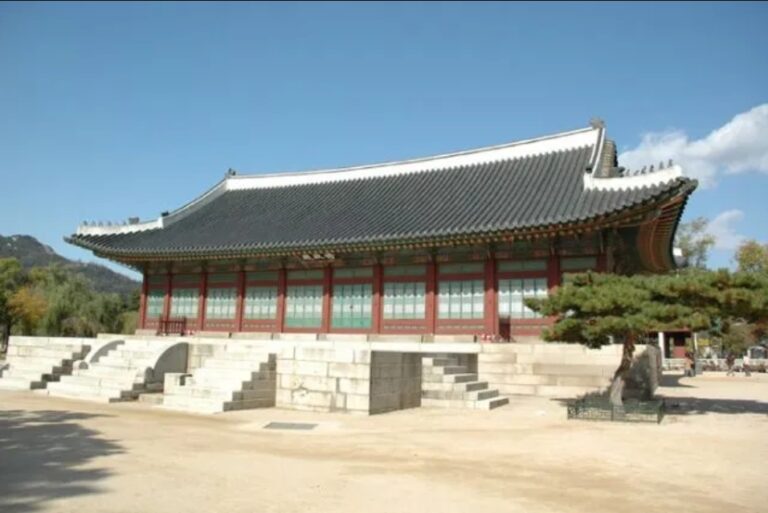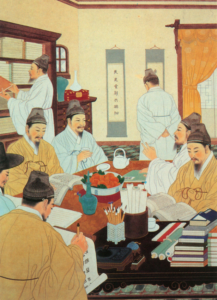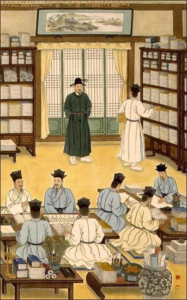Introduction
Jiphyeonjeon (집현전), known as the Hall of Worthies, was a royal research institute during the Joseon Dynasty that epitomized the scholarly spirit of the era. Established in 1420 by King Sejong the Great, it became a vital center for research, policymaking, and cultural development in Korea. Beyond merely a think tank, Jiphyeonjeon laid the foundation for some of Korea’s most iconic intellectual achievements, including the creation of Hangul.
This article delves into the origins, contributions, structure, and legacy of Jiphyeonjeon, drawing from reputable sources including the Korean National Heritage Administration and the Encyclopedia of Korean Culture.

Purpose and Function
Jiphyeonjeon was not merely a symbolic institution. It had practical functions that deeply influenced the Joseon court and society:
- Policy Advising: Scholars debated and drafted policies to assist the king in governance.
- Literary Compilation: They worked on preserving, editing, and interpreting classical Chinese texts and Korean documents.
- Educational Reform: Scholars were instrumental in improving the curriculum for state examinations.
- Scientific Inquiry: Jiphyeonjeon became a hub for studies in astronomy, meteorology, agriculture, and more.

Contribution to the Creation of Hangul
Arguably the most renowned achievement of Jiphyeonjeon is its role in the creation of Hangul, the Korean alphabet. King Sejong, concerned that the common people could not express themselves due to the complexity of Chinese characters, initiated the project to create a writing system that was easy to learn and use.
In 1443, Sejong gathered linguists and scholars from Jiphyeonjeon, and by 1446, the script known as “Hunminjeongeum” (훈민정음) was promulgated. While King Sejong is credited with its invention, the Hall of Worthies played a crucial role in research, development, and later dissemination.
Architectural and Cultural Legacy
Originally located within Gyeongbokgung Palace, the Hall’s primary building was Sujeongjeon (수정전), now preserved as a historical site. Although the original Jiphyeonjeon no longer exists, its historical value is commemorated through monuments and museum exhibitions. The Cultural Heritage Administration of Korea recognizes it as a foundational institution in the development of Joseon’s scholarly culture.
Today, the preserved Sujeongjeon Hall stands as a cultural symbol and educational heritage site, welcoming scholars and tourists interested in Korea’s intellectual past.
Dissolution and Aftermath
Despite its great contributions, Jiphyeonjeon faced a tragic end. In 1456, after the coup that brought King Sejo to power, several members of the Hall of Worthies were executed for plotting to restore the dethroned King Danjong. The institution was subsequently dissolved, and its scholarly activities absorbed by other state bodies.
Yet, the ideals and works produced by Jiphyeonjeon had already left an indelible mark. It inspired future generations to value education, integrity, and public service.

Lasting Influence in Modern Korea
The legacy of Jiphyeonjeon lives on in many ways:
- Hangeul: Now the official script of Korea and praised globally for its scientific design.
- Confucian Values: The Hall reinforced the ideals of moral governance and scholarship that remain embedded in Korean culture.
- Educational Excellence: The emphasis on learning and civil service set standards that still influence Korea’s academic culture.
Institutions like the Academy of Korean Studies and the National Institute of Korean Language continue the spirit of Jiphyeonjeon, pushing forward scholarly work on Korean linguistics, history, and philosophy.
For those building content around Korean heritage, Jiphyeonjeon is a keyword-rich topic that supports search engine visibility. Incorporating terms like “King Sejong,” “Hangul creation,” “Joseon dynasty history,” and “Confucian scholarship” will improve discoverability. Moreover, using authoritative citations from organizations like the Cultural Heritage Administration and the Encyclopedia of Korean Culture boosts credibility, enhancing both user engagement and AdSense approval potential.
Conclusion
Jiphyeonjeon served as the driving force behind intellectual innovation during one of Korea’s most enlightened reigns . It not only helped craft a national script but also shaped the moral philosophy that guided governance. As a result, its contributions remain deeply embedded in the fabric of Korean identity.
Even today, the Hall of Worthies continues to shine as a beacon of scholarly excellence in Korea’s cultural legacy. For educators, researchers, and cultural enthusiasts alike, exploring Jiphyeonjeon offers valuable insight into how knowledge, leadership, and collective wisdom can shape the destiny of a nation.
References
Other Relevant Readings
Introduction & Hangeul >>
